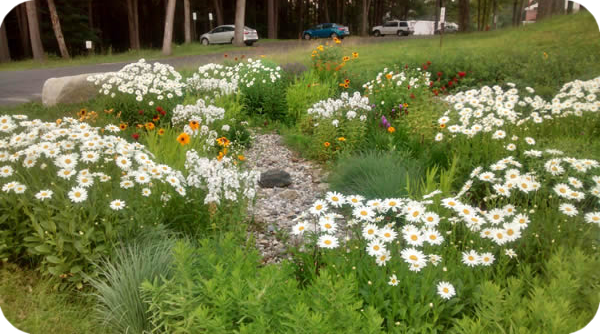Application: Aquifers, buildings, houses, markets, stormwater outfall
Description: A rain garden is a small bioretention cell that cleans and reduces stormwater in volume once it enters the rain garden. Specially designed garden beds slow the velocity of stormwater runoff and give it more time to infiltrate. Runoff is collected and settle on the garden surface, then soak through the plants and soil layers before entering the groundwater system. Rubbish and sediment is trapped on the surface. Nutrients dissolved in the stormwater are used by the plants and toxins stick to the soil. Root systems enhance infiltration, maintain or even augment soil permeability, provide moisture redistribution, and sustain diverse microbial populations. Also, through the process of transpiration, rain garden plants return water vapour to the atmosphere. The soil and plant roots work together to naturally filter the water and remove pollutants. A rain garden improves water quality in nearby bodies of water and ensures that rainwater becomes available for plants as groundwater rather than being sent through stormwater drains straight out to sea.
Contribution to climate resilience: A rain garden cleans stormwater, thus improving water quality for nearby water bodies. This reduces demand for freshwater supplied by local water authorities. By slowing down water velocity, a rain garden also ensures that more water is absorbed into the ground (thus replenishing groundwater) rather than being drained out to sea. Improved management of water is one of the best ways to improve resilience to likely changes in climate.
Supplementary sources of information:
http://www.lowimpactdevelopment.org/raingarden_design/whatisaraingarden.htm
https://www.epa.gov/soakuptherain/rain-gardens
http://mother-natures-backyard.blogspot.com/2013/03/harvesting-rain-rain-gardens-and.html
This resilience-building measure is sourced from the Water Resource Adaptation Guide (2019) published by the National Council for Sustainable Development at the Ministry of Environment in Cambodia. The full Guide is available to download at URL https://ncsd.moe.gov.kh/sites/default/files/2019-10/Water%20Resources%20Adaptation%20Guide_March%202019_En.pdf


